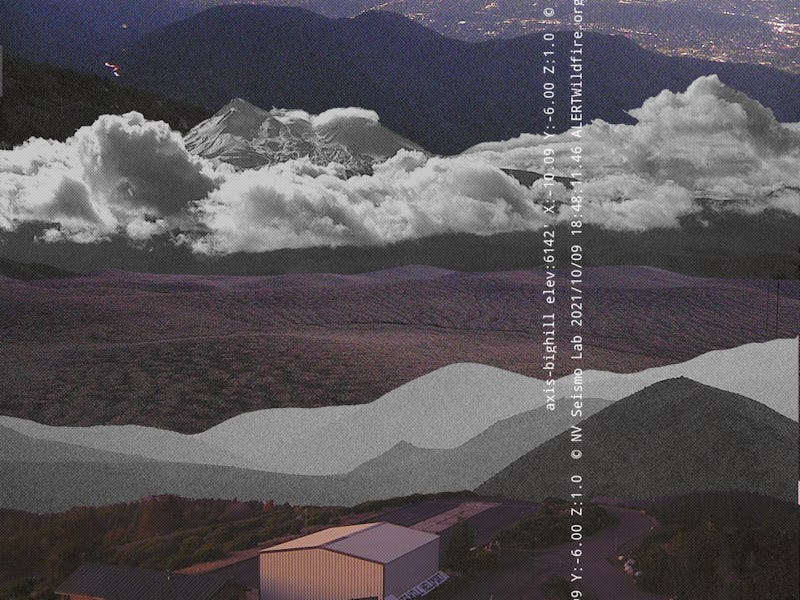The world is burning, but at least we have the California Landscapes Bot


The world is burning, but at least we have the California Landscapes Bot
Everything is collapsing. The senators are insider trading. The algorithm is relentlessly selling the most tepid, flavorless version of your life back to you. The last remaining industries are meal delivery apps, “cloud software,” and threadbare money laundering schemes. Your account has been deducted a fee and you’re just now hearing about it for the first time. We fluctuate between rage and limp nihilism and back again, and while this biweekly column won’t fix that, it will provide you with a small good thing to appreciate, a recognition of something weird and valuable and beautiful, despite it all.
***
You may find yourself thinking about the end of the world.
There are fires that burn with such absurd intensity they create their own weather systems, leaping across interstates. California droughts that drive desperate bears out from the forest and onto the crowded beaches of Lake Tahoe to cool off in the water. All day petulant billionaires lecture us on life as abstract idea, as infinite oasis – what did space travel teach me about being alive? – while life for the rest of us is just a relentless, grinding arithmetic – how much do I have to pay to not die? Modest climate legislation is laughed at as naïve, the delusions of a child, and then carved down to its bones by senators who’d appreciate it if you thanked them for their generosity. The sports franchises are run by ex-private equity psychos with horrible beards; the tv shows all feel like a meme from six months ago. The cruel insincerity of the term “fulfillment center” and how everything is called something like this now, parasitic institutions polished with benevolent-sounding marketing language. Oil and pharmaceutical corporations duck lawsuits with methods so brazen you will not believe it, you will ask someone to explain it to you again. Meanwhile the damp tyrants of Silicon Valley dream up the future of civilization: a videogame where you go to meetings.
The apocalypse is irresistible because it is finally a resolution, a culmination of all this rot; if not an antidote then at least a reprieve. But the asteroid never comes, the flooded subway tunnels drain. Instead there is only the drudgery of a society that needs you alive enough to buy A New Fried Chicken Concept but not enough to prosper. You’re left with filthy landlords, emails piled at your door, cities that all feel increasingly like an airport bathroom. They bulldozed everything you ever loved and on the rubble built a juice bar where the menu is written in all-lowercase and the walls are made of artificial grass, because your life now is “casual” but also “exotic.” It is not actually these things, not even close, but imagine them as a pitch deck, imagine a startup co-founder named Mason telling you your life can be a whole ass mood.
I suggest the possibility that you have felt pummeled by all of this and considered the end of the world because I have been there too, am there, alternately obsessed with every new forensic detail about our wheezing, pillaged earth and wishing I had never heard of them at all. I am going a little insane, is what I’m saying. Up late with movies paused so long the screensaver activates, scrolling my phone for things like “monarchs who died in battle” and “rarest figs.” Zoned-out admiring the just-cleaned kitchen counter like it were a Lamborghini. Seeking things that will not rescue me but that are vital still in indestructible ways. These are our recreations, the tiny mercies of modern life.
It was here this past year, somewhere at the nexus of doom and malaise, that I came to depend on the California mountains, delivered to me by the California Landscapes Bot. The bot is a project conceived of by Hunter Owens in 2019 and managed with the help of Logan Williams. Owens lives in California; Williams did until last year, when he moved to Europe. The bot works by attaching itself to ALERTWildfire, a network of hundreds of cameras that were fastened to cell phone towers high up in the hills and mountains of California to monitor the wilderness for signs of fire. The cameras are everywhere. As far south as Otay Mountain, about 20 miles from Tijuana, and all the way up along the coast, where at some sites the cameras will oscillate and catch the Pacific Ocean, stretching forever behind the pines. They’re as far north as Washington and Oregon and out on the Nevada border, where at night the feed is blasted with stars and silhouettes of land that look like Mars. The recordings from each camera in the network are transmitted to an observation hub online that anyone can access. The bot randomly selects a camera site about once every 30 minutes and captures the most recent frame of the feed at that moment. That’s the image it sends us.
What we’re seeing is just the preposterous beauty of California synchronized with a robot’s obedience to documenting it.
The bot’s feed looks at first like it must be curated, the way every scene feels perfectly arranged and momentous – a closing credits sequence; an ascension to somewhere powerful. But when I asked Owens and Williams they told me there is almost no curation at all. (On one instance, Williams did augment the bot’s selection to include a camera site where, after dark, a comet could be seen falling across the sky above the San Joaquin Hills.) Williams never even implemented a bias in the bot’s schedule toward capturing sunrises and sunsets, as they have on other similar projects. What we’re seeing is just the preposterous beauty of California synchronized with a robot’s obedience to documenting it. Another of Owens’ bots, “traffic-west,” pulls frames from the feeds of traffic and weather cameras across the western US. This project is ghostly too, the bone chilling solitude of an empty road in the middle of nowhere, gas stations on the fringes, but it is often just roadwork signs and rain, 18-wheelers and beat-up sedans chugging past strip malls. California Landscapes never misses.
Mountains in Monterey County that stand like preachers looking down below to a congregation of clouds. Sunrises over Los Angeles that will demolish you. Skies of every color, overripe mango and Pepto Bismol pink. Mount Whitney looking like a John Ford movie. Pine trees farther north, in Butte County, of such uniform height and density it’s as if they’d been buzzed with barber clippers. Mansions clinging to the hills in Hollywood. Dozens and dozens of neatly laid rows of grape trees in Solano County. The way the fog hangs in the valleys in the early morning like a gunfight just broke out in a saloon in a western.
I asked Williams about California’s ability to constantly reveal something spectacular and newly specific about itself in the pictures the bot relays.
“To me, it makes this feeling all the more oceanic to know that it is not actually a special image, but that at this moment there are countless ridgelines and valleys with equally stunning vistas, so many unwitnessed by humans or cameras,” he wrote in an email. The seemingly-boundless but actually very fragile simultaneity of it all is overwhelming, awe inspiring, unwitnessable.”
The footage from each observation site is archived for a rolling 12 hours before it disappears forever. So every scene the bot peels from these cameras is something brilliant, a miracle, because it is the first of its kind, and then extinct. The way the sky looked for that exact fragment of time. This does not solve the sweltering madness of consciousness in 2021, our lack of any trajectory besides erosion and exhaustion, but it is something gorgeous and ridiculous, it will temporarily reach out and pluck you from the abyss and say, look at this, can you believe it?
It’s not exactly nature but it’s also not indoors. It’s not going somewhere but it’s also not wallowing. It is reliable. You can count on the mountains, is the thing.
There is an almost hallucinatory effect to scrolling the feed, posted chronologically, a taste of Old Internet, days and days of devotion to one thing only, its muse, California going to sleep and coming alive again, little white dots of city light in nightvision mode, sometimes a glimpse of something by accident, picnic tables and observatories. It is a mix of montage and shrine, the raw honesty of surveillance footage but with the romantic hue of a postcard. It is being in a long distance relationship with California, texting you pictures of itself through its day. It is not a podcast advertisement for a gambling app, it is not a notification bubble in a color gradient calculated specifically to hijack our brain. It is a moment with a place that does not look like it has wifi. It’s not exactly nature but it’s also not indoors. It’s not going somewhere but it’s also not wallowing. It is reliable. You can count on the mountains, is the thing.
The twisted irony is that these cameras are not meant to be a mosaic of California. They are the electrode pads of an EKG we had to stick to its chest to track the exact speed at which we are killing it. In the summer and early fall the feeds often capture terrifying blazes erupting from the hills, barfing black smoke across entire landscapes. In August of 2020 a fire tore across Bonny Doon, a town of about three thousand people near Napa where there was an ALERTWildfire camera installed. The last transmission to the network was of the camera staring down the cell phone tower at a screen of flames that looked like you’d pressed the humming orange filament of a lightbulb to your eye. Since the bot is designed to retrieve the most recent logged image, each time it cycled to the Bonny Doon site it pulled and posted the identical scene of the fire devouring the camera, over and over, the forests stalking you like a ghost, howling for all eternity.
In the feeds of many of the cameras, in the upper right hand corner of the screen is an icon that says ‘IMAGE COURTESY OF PG&E’, California’s largest and famously grotesque utility company, whose rampant negligence has caused many of the fires. Here again, our apocalypse predicament. The natural earth and every last good granule on it crushed between the fists of one cataclysmic event or another, gluttonous corporations with their teeth sunk in, orchestrating shameless PR campaigns while a robot glitches just slightly.
All of this seems undeniable. But what can you do? Millions of years ago the earth smashed into itself so violently mountains ruptured up from the surface. The Pacific Ocean once covered some of these California valleys and developers have found, breaking ground on housing projects, the skeletons of whales that anthropologists believe once swam in them. Completely in-tact spines and vertebrae pulled from the dirt. The whales are gone now and in the same valleys we are here instead, you and me and all of us, in the back of cabs, adrift online, hungover trudging through crosswalks, trying to make it. In the distance the mountains are still and quiet, a planet that is fragile but in its way also immortal, overwhelmed but outlasting the crooks. I have to believe this is true. Look at them standing there.